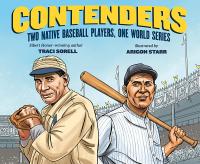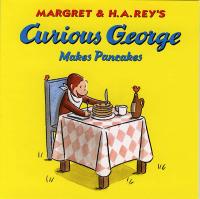
The O’Malley family is off to the beach, but it’s a long, hot, boring drive. What can Eric, Bridget, and Nell do to keep busy? Play tally games, of course — counting up all the gray cars or green T-shirts they see. Whoever has the most marks at the end wins the game. This is a great picture book for teaching data collection and tallying. It also gives kids a head start in counting by fives and is a good basis for charts and graphs.
Tally O’Malley

Four best friends start a lemonade business and make a bar graph to chart their growing sales. After three days the friends notice that their sales suddenly drop and investigate to find out why. After discovering that the competition is a new kid with a great juggling act just down the street, they ask him to perform beside the lemonade stand and then watch sales increase “over the top.”
Lemonade for Sale

Chester the snail sets up a contest between his friends Gonk the toad and Beezy the lizard to see who can make the best graph. Points will be given for correct math, creativity, and neatness. Beezy and Gonk explore information collection (tallies and surveys) and the use of graphic organizers (Venn diagrams, quantity graphs, circle graphs, picture graphs, and bar graphs). In the end, kids can look at Chester’s graphically designed score sheet and see that the result is a tie.
The Great Graph Contest

A powerful poem and stunning, handmade-paper art encourage children to protect nature.
“Where once there was a wood,
A meadow and a creek … “
Inspired by events in her own backyard, award-winning author and illustrator Denise Fleming creates a poignant yet hopeful portrait of our disappearing natural environment. The last pages of the book teach children how to make a more “creature friendly” backyard, including information about what types of food, trees and flowers attract different kinds of animals.
Where Once There Was a Wood

Meet Julia! Julia is an autistic girl who loves art and her family. Join Elmo, Abby, and the rest of the Sesame Street crew as they introduce Julia and all the things that make her special.
My Friend Julia: A Sesame Street Book About Autism

The true story of John Meyers and Charles Bender, who in 1911 became the first two Native pro baseball players to face off in a World Series. This picture book teaches important lessons about resilience, doing what you love in the face of injustice, and the fight for Native American representation in sports.
Contenders: Two Native Baseball Players, One World Series

Aven Green loves to tell people that she lost her arms in an alligator wrestling match, or a wildfire in Tanzania, but the truth is she was born without them. And when her parents take a job running Stagecoach Pass, a rundown western theme park in Arizona, Aven moves with them across the country knowing that she’ll have to answer the question over and over again. Her new life takes an unexpected turn when she bonds with Connor, a classmate who also feels isolated because of his own disability, and they discover a room at Stagecoach Pass that holds bigger secrets than Aven ever could have imagined.
Insignificant Events in the Life of a Cactus

Whether in the sky, on the land, or in the sea, animals live in all sorts of fascinating environments. Discover six of the most intriguing habitats, and have fun pinpointing the camouflaged critters hiding within them in this interactive and informative picture book full of furry, feathery, and ferocious creatures.
I See a Kookaburra! Discovering Animal Habitats Around the World

“I can’t wait for my hair to grow” is the powerful opening to this book, which lays groundwork for this compelling story highlighting not only the significance of hair to Indigenous peoples, but also memory, generational trauma, and the power of healing. Using three generations of hair as the medium, Lindstom’s sparse, poetic language (“Our ancestors say: Our hair is our memories. Our source of strength”) and Littlebird’s bright palette capture both serenity and hope. (School Library Journal)
My Powerful Hair

This book celebrates the magic of discovering your very own poetry in the world around you. “Begin / with a question / like an acorn / waiting for spring.” Written as a step-by-step guide, and using language including “first,” “next,” and “then,” the authors teach the art of poetry. Readers are prompted to first ask a question, and then to “listen to the grass, the flowers, the trees — anything that’s friends with the sun” to create imagery for their poetry. The book teaches poetry by tasking students with exploring nature, questions, and ideas in unique ways.
How to Write a Poem

A book of poems about dancing that mimic the rhythms of social dances from cha-cha to two-step — celebrating all forms of social dance from samba and salsa to tango and hip-hop. The rhythm of each poem mimics the beat of the dances’ steps. The poems create a window to all the ways dance enters our lives and exists throughout many cultures.
Feel the Beat: Dance Poems that Zing from Salsa to Swing

A window into a child’s experience of the Great Migration. Climbing aboard the New York bound Silver Meteor train, Ruth Ellen embarks upon a journey toward a new life up North — one she can’t begin to imagine. Stop by stop, the perceptive young narrator tells her journey in poems, leaving behind the cotton fields and distant Blue Ridge mountains.
Overground Railroad

“I can hear change humming/ In its loudest, proudest song./ I don’t fear change coming,/ And so I sing along.” As a young girl leads a cast of characters on a musical journey, they learn that they have the power to make changes — big or small — in the world, in their communities, and in most importantly, in themselves. Lyrical text and rhythmic illustrations is a call to action for everyone to use their abilities to make a difference.
Change Sings: A Children’s Anthem

The confident Black narrator of this book is proud of everything that makes him who he is. He’s got big plans, and no doubt he’ll see them through — as he’s creative, adventurous, smart, funny, and a good friend. Sometimes he falls, but he always gets back up. There are superheroes in our midst!
I Am Every Good Thing

A playful, illustrated guide to a simple meditation practices for young children experiencing stress, difficulty focusing, and difficult emotions. All you’ll need to practice it is a quiet spot and four ordinary pebbles.
A Handful of Quiet: Happiness in Four Pebbles

In this picture book about voting and elections, the students of Stanton Elementary School learn how we can find — and use — our voices for change. Every two years, on the first Tuesday of November, the school closes for the day so that it can transform itself into a polling station. People can come from all over to vote for the people who will make laws for the country. The students might be too young to vote themselves, but that doesn’t mean they can’t encourage their parents, friends, and family to vote! After all, voting is how this country sees change — and by voting today, we can inspire tomorrow’s voters to change the future.
Vote for Our Future

Thus begins a lyrical journey through the days and weeks, the months, and the changing seasons in the life of one New Englander and his family. The oxcart man packs his goods and travels over hills, through valleys, by streams, past farms and villages. At Portsmouth Market he sells his goods. Then, with his pockets full of coins, he wanders through the market, buying provisions for his family, and returns to his home. And the cycle begins again.
Ox-Cart Man

Once there was a little girl with a big guitar from Cotton Plant, Arkansas, who would grow up to be an unconventional musician with a major influence on icons including Chuck Berry, Elvis Presley, and Johnny Cash. The narration evokes Rosetta’s musicality and is effectively complemented by expressive paintings. Additional information is included.
Rock, Rosetta, Rock! Roll, Rosetta, Roll!

A picture-book biography of Sister Rosetta Tharpe, the woman who invented rock and roll — a warm, inspiring tale of a childhood filled with music, community, and a drive to succeed. “Music is the heart of our story” says Momma to young Rosetta, surprising her with her first guitar. Rosetta‘s strums sound like ker-plunks. But with practice and determination, she makes music, fingers hopping “like corn in a kettle,” notes pouring over the church crowd “like summer rain washing the dust off a new day.”
Little Rosetta and the Talking Guitar: The Musical Story of Sister Rosetta Tharpe, the Woman Who Invented Rock and Roll

Storms delay travelers at a Chicago airport but it is a lost toddler and a mistake by TSA staff that connects young Asian Americans in this series of interconnected short stories by a range of Asian American writers. Sometimes humorous, sometimes serious, the book highlights the diversity of Asian Americans as well as the biases they often confront.
You Are Here: Connecting Flights

As the Revolutionary War rages on, Isabel and Curzon have narrowly escaped Valley Forge—but their relief is short-lived. Before long they are reported as runaways, and the awful Bellingham is determined to track them down. With purpose and faith, Isabel and Curzon march on, fiercely determined to find Isabel’s little sister Ruth, who is enslaved in a Southern state — where bounty hunters are thick as flies. Return to the American Revolution in thisconclusion to the middle grade Seeds of America trilogy.
Ashes

The Patriot Army was shaped and strengthened by the desperate circumstances of the Valley Forge winter. This is where Curzon the boy becomes Curzon the young man. He navigates the dangers of being a runaway slave in this second novel in the historical middle grade The Seeds of America trilogy.
Forge

When yellow fever strikes 18th century Philadelphia, 16-year-old Matilda’s life is forever changed. Contemporary readers are likely to see themselves in Matilda while being transported back in time through striking smells and sights of an earlier time.
Fever 1793

Every year, George and the man with the yellow hat attend a pancake breakfast to benefit the children’s hospital. Always curious, George finds his way to the pancake table and helps out. Pouring batter and flipping the pancakes over looks like fun! George decides to make some pancakes of his own, and after making and serving some of the most delicious pancakes the crowd has ever seen, George gets into even more monkey mischief.
